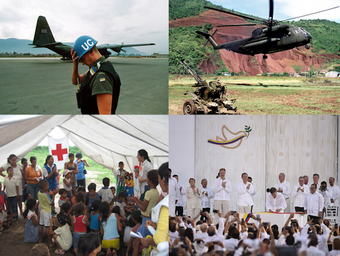Chaibian War
This article is incomplete because it is pending further input from participants, or it is a work-in-progress by one author. Please comment on this article's talk page to share your input, comments and questions. Note: To contribute to this article, you may need to seek help from the author(s) of this page. |
| Chaibian War | ||||||||
|---|---|---|---|---|---|---|---|---|
| Part of the Atomic Age (1945–present) | ||||||||
 Clockwise from top left: A Fallish UC peacekeeper during UCOMCA involvement in the Battle of Caridoso in 1989, a Nadauran military helicopter hovers over an abandoned FLP anti-aircraft weapon in 1987, the Easter Agreement is signed by President Tadeu Espíndola in 1990, internally displaced persons in Itzalcoatl | ||||||||
| ||||||||
| Belligerents | ||||||||
|
Supported by: |
Nadauran drug cartels and right-wing paramilitaries
Supported by: X |
Nadauran guerrillas
Supported by: X | ||||||
| Commanders and leaders | ||||||||
|
| ||||||||
| Strength | ||||||||
|
Ground Self-Defense Force: 177,400 Naval Self-Defense Force: 47,250 Air Self-Defense Force: 33,350 National Police: 267,560 |
Paramilitary and successor groups: 4,500–26,000 CLUN: 40,200 |
FLP: 34,000 (2015) ER1M: 13,890 (2006) MAR: 1,200 (1990) | ||||||
| Casualties and losses | ||||||||
|
19,840 injured (1982–1990) |
39,000 demobilized 1,740 captured Armala cartel: 3,400 killed |
22,000 demobilized (since 2016) 900 captured (since 1985) 4,000 captured (since 1990) | ||||||
|
Civilians killed: 164,427 Individuals abducted: 25,027 Total number of individuals displaced: 3,363,000–5,100,000 Total number of refugees: 100,000+ | ||||||||
The Chaibian War (Lavish: Guerra do Chaibia), also referred to as the Nadauran War (Lavish: Guerra do Anadaúro) and commonly as A Violência (lit. "The Violence"), was a low-intensity conflict dominated by asymmetric warfare throughout the 1980s between the federal government of Nadauro and the state government of Chaibia, far-right paramilitary groups, drug cartels, and far-left guerrilla groups, following the collapse of the Caravelas regime and the Third Empire of Nadauro in 1979.
The power vacuum left behind by the rapid paradigm shift of Nadauran power was swiftly exploited by numerous factions vying for control in the then-impoverished and underdeveloped state of Chaibia. Previously having been the center of popularity for the fledging Combinationalist Workers' Party (PMC) and minor secessionist groups advocating for Chaibian independence, differing political visions and desires caused conflict. In December of 1981, hoping to provide social justice through combinationalism, the PMC re-organized into the Popular Liberation Front (FLP) and initiated the outbreak of violence. By January of 1982, public order largely collapsed in Chaibia.
The Nadauran government's response was harsh and initially unyielding; on 30 September 1985, President Enrico Pimentel was assassinated in Itabira by the Revolutionary Army of 1st of March (ER1M) after repeatedly rejecting political concessions in the far-left groups' favor. Anti-combinationalist suppression by the government military in Chaibia prompted the creation of multiple far-right paramilitary groups such as the United Free Corps of Nadauro (CLUN), supposedly reactionary to the guerrilla activity, and the involvement of both domestic and international drug cartels and crime syndicates. The peak of wartime activity occured from 1987 to 1989, during which large parts of territory in Chaibia were effectively occupied by multiple fighting groups; major events include the 1987 Hotel Marizur bombing, the Battle of Selmestas, and the 1988 Bahia Minor raid.
Juan Manuel Duque pursued a controversial peace policy during his tenure in the late 1980s, negotiating the disbanding of CLUN and a temporary truce with FLP and ER1M in March of 1988; the peace deal fell apart when the rejecting National Congress moved against Duque with a vote of no-confidence in January of 1988. Fearing regional spillover, the United Congress Security Council passed Resolution 609 and created the United Congress Observer Mission in Nadauro (UCOMCA) to aid in peacekeeping and monitor the Nadauro–X border. Following the climactic Battle of Caridoso in August of 1989, diplomatic efforts by presidential successor Tadeu Espíndola culminated in the Easter Agreement, a historic ceasefire agreement signed on 4 August 1990.
The Nadauran peace process has made steady progress since the 1990s and the 2000s, even when experts consider it to be fragile. According to a study by the University of Itabira, a total number of 235,000 people have died in the conflict from 1982 to 2010, the vast majority of which civilians (up to 80%). Estimates of the number of internally displaced persons range from 3.4 to 5.1 million people, generating the world's third-largest such population. According to UCCAF, 37,000 children have been killed in the conflict and another 1.8 million designated as "victims"; human trafficking, more notably child trafficking, persist as broader societal issues and are the subject of political and public attention.

